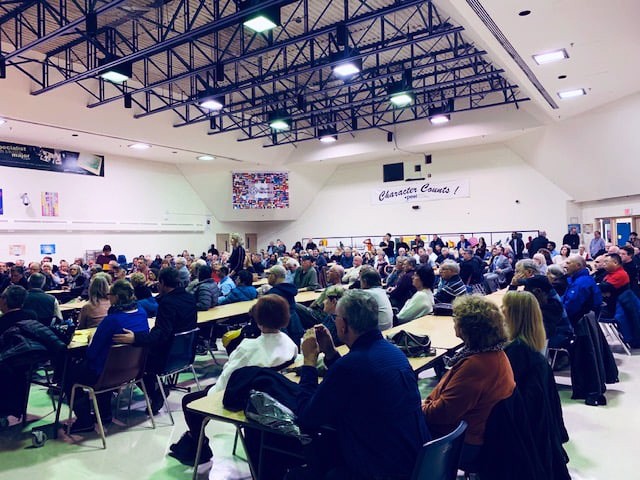
Hundreds protest development plan in Brampton’s north end; issue highlights challenges of smart growth
A development plan set to go before council next week has raised the ire of hundreds of residents in the surrounding area, who claim the density proposed does not fit with the area and will only put further pressure on already burdened infrastructure.
However, with Brampton’s population expected to inflate significantly over the next 20 years, the city must be smart when it comes to planning new development to house the influx of new residents.
Infill growth and more dense developments like the one proposed are increasingly being viewed as good city planning by experts. But can it work in a city accustomed to sprawl, with many residents demanding the same housing stock that has created financial problems for Brampton – large single family subdivision homes that require expensive infrastructure and don’t return much tax revenue to municipal coffers?
The community members, some of whom will be speaking during Monday’s planning and development meeting, would say no, and the ongoing debate shines a light on a problem that will become much more common in Brampton as the city grows and adopts the principles of its 2040 Vision plan for growth, unless common ground can be found between the old attitudes and new approaches to city building.
The proposal in question is being put forward by Paradise Developments and includes 360 dwelling units, 182 of which would be single-detached homes, and 178 townhouse dwellings.
In terms of Brampton’s sprawling subdivisions in the north end, the proposal is rather small, but according to resident Linda Longland, it could put serious pressure on the area’s existing infrastructure.
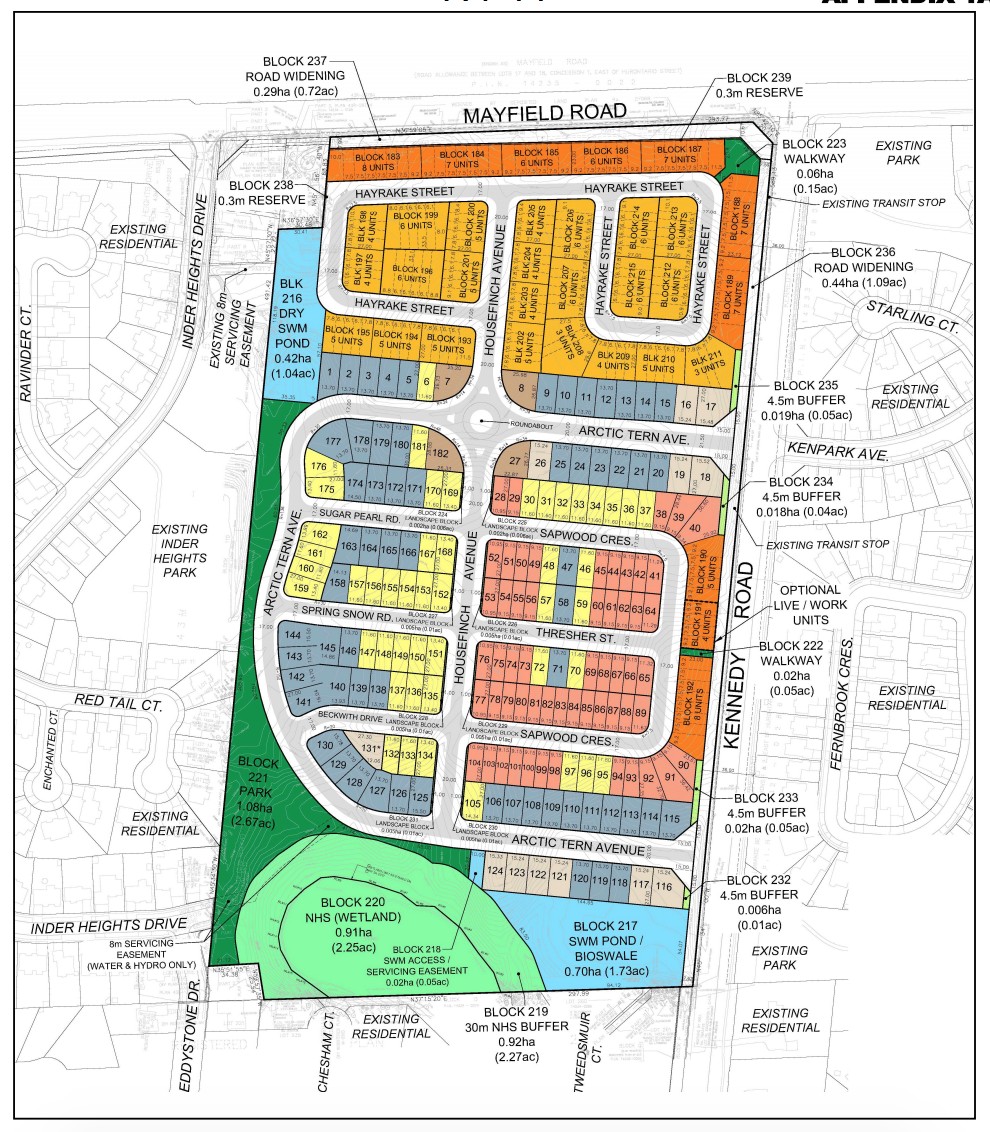
The current proposal includes 360 dwelling units, 182 of which would be single-detached homes, and 178 townhouses.
“We understand that urbanization is happening, a more dense community does make sense in terms of carbon footprint, it just seems that the city has infrastructure as an afterthought,” she says. “It doesn’t seem like the infrastructure can support a development like this.”
The proposed project has been in the works for several years, and the report going before council — with a staff recommendation for approval — has all the boxes checked. The staff report praises the proposal as good planning, consistent with the overarching provincial growth plan, and the Region of Peel Official Plan and the city’s own Official Plan. Put simply, on paper, the development fits perfectly.
“The proposed development is an appropriate use within the context of the surrounding planned community. From a safety perspective, access to the subject property via Kennedy Road are appropriate with respect to potential traffic impacts. From a health perspective, residents can access pedestrian and cycling opportunities and both active and passive recreation via the existing and proposed trail system and the new park within the subdivision plan and an upgraded Inder Heights Park,” the analysis reads.
Resident Tiere Sharma disagrees, especially with the proposal’s claims around traffic impacts. The intersection of Mayfield Road and Kennedy Road, where the development sits on the south-west corner, is already extremely busy, she says. Adding between 1,200 and 2,000 people as the development projects, would only make things worse.
“This whole area is going to be a nightmare,” she says.
Longland and Sharma aren’t the only ones speaking out. A town hall meeting held earlier this month saw over 300 local residents turn out to voice their concerns with the project.
This follows on the heels of a petition put together by the local North Brampton Neighbours group that received nearly 700 signatures in opposition.
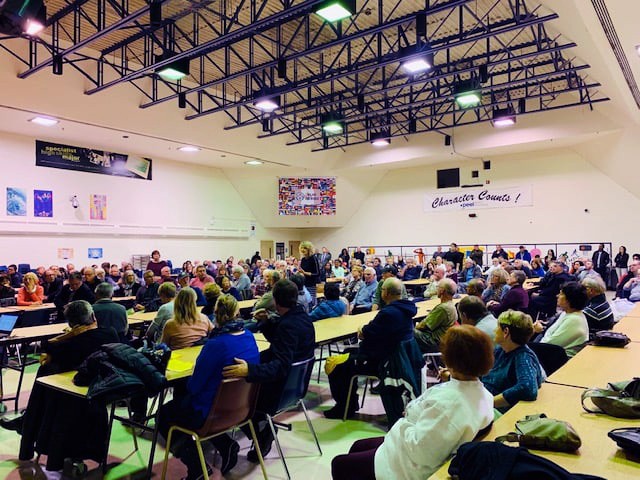
Over 300 residents attended a town hall to provide feedback on the development.
The community isn’t under any illusions, Longland states. She’s lived in the area for 27 years and has always known it was ripe for development, but this proposal is not taking into account the surrounding community, she says, which is all single-detached homes.
“By putting in almost 50 percent of the dwellings to be townhouses, is what I find, most people are opposed to,” she says. “We’re not opposed to the development at all, we understand that this is valuable land, we understand that Paradise has already paid for it.”
Additionally, while things may appear good on paper, looking a little closer shows that the situation may not be as rosy as the staff report makes it out to be.
For example, a small, provincially significant wetland sits directly to the south of the proposed development.
The wetland is accounted for in the plans, and a 98-foot buffer has been assigned in order to avoid disturbing the valuable habitat. Additionally, the “passive” uses of the stormwater management ponds and the proposed community park will also be located on this side of the development to further the buffer “and enhance connectivity of existing natural and recreational spaces,” the report reads.
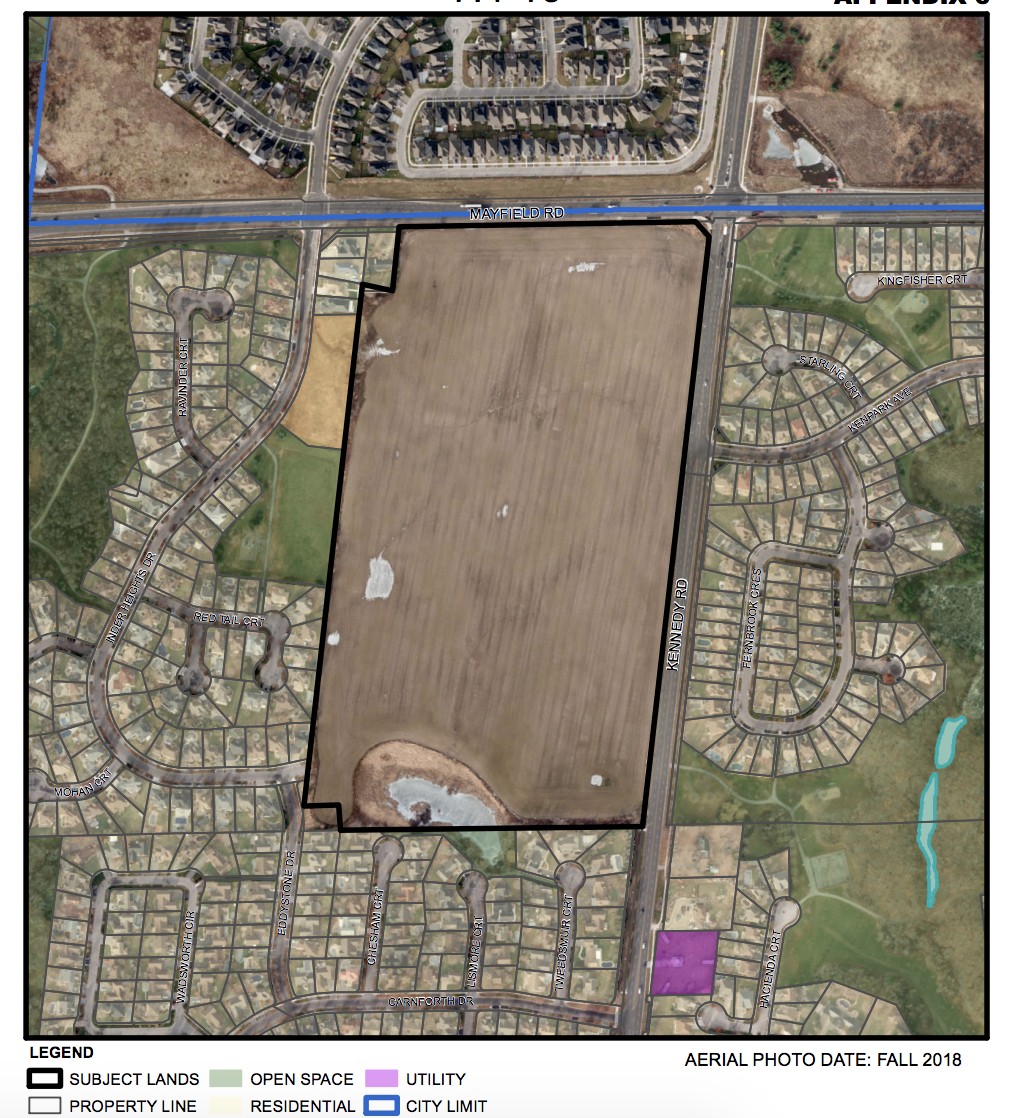
A provincially significant wetland is partially located on the southern portion of the proposed development.
However, as a recent report from the city shows, this buffer may not be enough. A number of the city’s lakes have suffered under the growing strain from surrounding urban development.
Save for Professor’s Lake, all of Brampton’s water bodies are classified as not fit for swimming, including Heart Lake, Loafer’s Lake and North Place Park Pond.
A recent report that went before Brampton city council detailed the state of these water bodies, noting that many of them suffer from harmful algal blooms and water quality concerns, “issues typically associated with urban water bodies,” the report notes.
Wetlands are more than water bodies, and growing evidence extolling their benefits has been brought forward over the last decade as these ecosystems can filter water, prevent flooding and provide valuable habitat for wildlife.
For a wetland, being close to urban development is like second-hand smoke. It’s not being paved over, but at the same time, it’s receiving greater input of sediments, nutrients and chlorides (think of the salt runoff from local roads in the winter) and other chemical pollutants simply due to their proximity to the city.
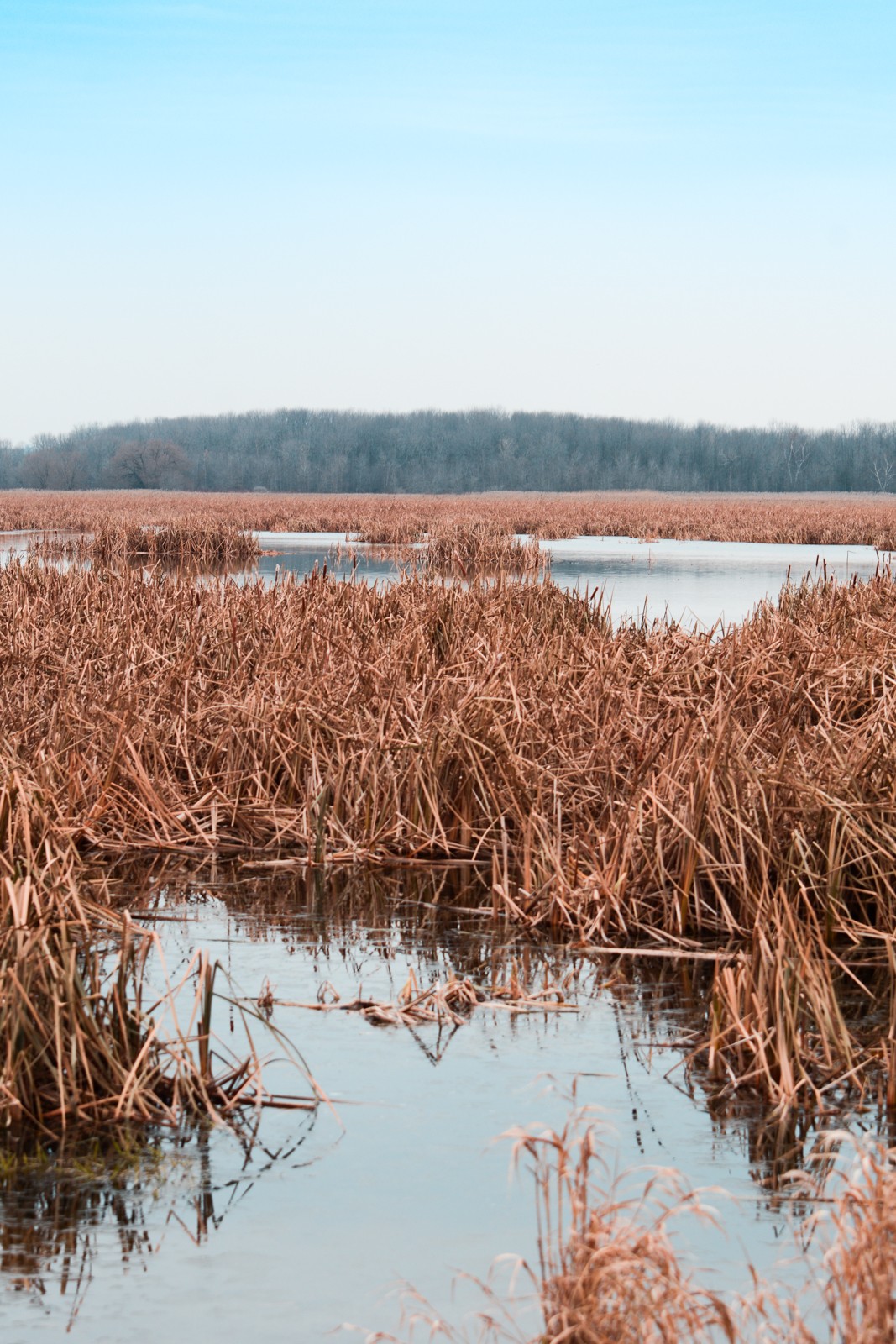
Urban wetlands can act as critical habitat for local wildlife while also providing benefits like flood mitigation to their surrounding municipalities.
“Numerous studies describe how urban wetlands respond to these stressors. Although the precise response depends on the sensitivity and landscape position of the wetland, the general trend is a sharp decline in the diversity of the native plant and animal community and an increase in invasive plant species that can tolerate stressed conditions,” a report from the Centre for Watershed Protection reads. “Research has shown that degraded urban wetlands lose many of their important watershed functions.”
This shouldn’t be news to urban planners as the report was written in 2006.
In the long run, unfortunately, this wetland, and others like it in Brampton, don’t stand much of a chance against the coming onslaught of development.
According to Brampton’s 2040 Vision, the city is expected to grow to approximately 306,000 dwelling units by 2040 (up from 170,000 in 2016) and the population is expected to surpass 1 million residents.
These people need to live somewhere, and a growing number of urban planning studies have found that construction developments, with more density than the sprawling subdivisions of the past, are the path forward.
The benefits of building apartments, condos, townhomes and other low-rise units over the sprawling expanses of outer suburbia were outlined in a report from Ryerson University’s City Building Institute in 2018.
Finding the Missing Middle in the GTHA (Greater Toronto and Hamilton Area) highlights several ways cities can begin to shift away from the “tall and sprawl” approach that has dominated for so long, with construction of high-rise apartments or condos at one end of the spectrum and single-family homes at the other.
The study recommends cities focus on infilling existing neighbourhoods with suitable (low-and medium-density) multi-unit residential developments. Creating this middle ground would shape more opportunities for housing and better affordability, the report finds. It could potentially allow people to work closer to home and get them out of their cars while using public transit more often, which becomes more realistic when people no longer have long daily commutes.
This would help reduce greenhouse gas emissions, thanks to preserving green space and reducing the number of cars on the road, a main source of GHG emissions.
“I totally agree that denser communities make more sense, they’re more environmentally friendly, and the city is able to make greener spaces,” Sharma says. “I agree with that, I just don’t think it’s appropriate for this parcel of land. This is already a very congested intersection.”

During last week’s town hall meeting, Councillors Michael Palleschi and Doug Whillans attended alongside Mayor Patrick Brown. All three of them vowed to vote against the development in its current iteration, signalling a small victory for the community. It’s unclear if the three members of council and the rest of their colleagues will move forward with their recent climate emergency declaration in mind.
City planning is the number one way for council to positively impact the climate reality facing the planet, but if they continue to push sprawl, unwilling to upset potential voters, this will not align with their commitment to turning around the conditions that are creating unsustainable temperature increase.
The Intergovernmental Panel on Climate Change last year released an alarming report that included research evidence from over 6,000 scientists around the world. They implored local leaders to stop planning for sprawl and other types of built form that are among the leading causes of temperature increase because of increased carbon needed to heat and cool large houses and the extra pollution created by a much larger carbon footprint when larger, more stretched out areas of land are needed to accommodate small numbers of people.
At Monday’s committee meeting, along with the community members who will be delegating, the president of Paradise Homes, Edward Weisz, is also slated to speak.
Email: [email protected]
Twitter: @JoeljWittnebel
Submit a correction about this story


